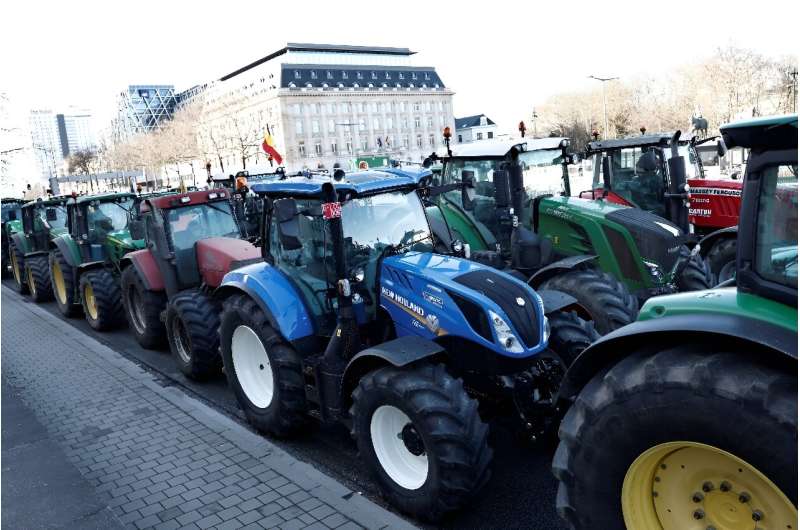This article has been reviewed according to Science X's editorial process and policies. Editors have highlighted the following attributes while ensuring the content's credibility:
fact-checked
reputable news agency
proofread
EU walks farming minefield with new climate goals

The EU's climate goals for 2040 are set to further dial up the pressure on a farm sector that has yet to get tough on greenhouse gas emissions—but is already up in arms over existing environmental rules.
With European elections just months away, the European Commission will Tuesday put forward its next major target for cutting the bloc's global warming emissions, and agriculture—which emits 11 percent of them—is a key part of the equation.
Politically the timing could hardly be worse, with farmer protests simmering across Europe—thronging Brussels with tractors last week—and populist politicians swooping in to ride the wave of discontent.
Environmental constraints are high on the farmers' list of grievances—both longstanding rules stemming from the bloc's common agricultural policy (CAP), and new ones from the sprawling environmental Green Deal that have yet to come into force.
The 27-nation EU has pledged to be carbon neutral by 2050, and to get there implies massive adaptation by industry and consumers.
A first target has been set for 2030: cutting emissions by at least 55 percent compared with 1990. For the next milestone, 2040, working documents suggest the EU will aim for a net drop of 90 percent.
But the Green Deal—having taken on emissions in transport, energy and manufacturing—has hit a rock when it comes to farming, faced with stiff resistance from the sector and from conservative lawmakers.
Emissions from agriculture—two thirds of which are linked to methane and manure from livestock farming, and the rest to nitrogen-based fertilizers—have been stable since 2005, according to Ottmar Edenhofer, chair of the European Scientific Advisory Board on Climate Change.
According to projections by the board, achieving a 90 percent target would require halving the bloc's livestock herd and slashing nitrogen fertilizers by 60 percent.
Edenhofer blames the status quo on a lack of incentives, since the CAP "continues to provide financial support to emission-intensive agricultural practices, including livestock production."
A report from the advisory board has recommended the CAP become "better aligned" with the bloc's climate goals: setting mandatory best practices, shifting support away from livestock production, and encouraging a less meat-heavy diet.
'Missing piece'
But the EU knows it must tread cautiously: in The Netherlands, an ambitious scheme to cut livestock numbers and nitrogen emissions sparked a farmers revolt—and a populist surge at the ballot box.
A working document from the commission points towards a more conciliatory approach on Tuesday.
Instead of singling out farmers, the focus appears to be on pushing agri-business as a whole towards more sustainability, while promising farmers aid and alternative sources of revenue from biofuels or carbon capture.
For Pascal Canfin, the chair of the European Parliament's environment committee, this is the "missing piece" of the political puzzle.
"The pressure has to apply not just to farmers, but to the entire food industry chain," said Canfin.
Canfin argues big food groups should be submitted to a carbon-pricing mechanism and pushed to finance large-scale reform by their suppliers—so the cost of sustainability is split fairly between farmers, and industry giants like Nestle or Danone.
'Fantasy'
Another touted solution is to pay farmers for capturing carbon in their soils and forests, with EU legislation in the works on a system of certification for these so-called carbon sinks.
In an impact study seen by AFP, Brussels puts forward net emissions targets that merge the impact of farming and natural carbon sinks.
But some advocates question that logic.
"When the commission says it will offset farm emissions with forestry, that's a little too easy, unfortunately," says the WWF's Michael Sicaud-Clyet.
"The only safe solution is to cut emissions," he added.
And advocates are also skeptical about the promise of bioenergy as a source of revenue for farmers, questioning the technology this hinges on, known as BECCS, which pairs biomass with carbon capture and storage.
Martin Pigeon, forest and climate campaigner at the NGO Fern, dismisses BECCS as a "fantasy".
"No one has ever managed to generate 'negative carbon dioxide emissions' from burning wood," he said.
If a drastic reduction in farming emissions turns out to be unattainable, the bloc will have to look elsewhere to meet its 2040 goals.
There could still be a path: the Strategic Perspectives think tank has devised models for attaining a 90-percent emissions cut that rely mostly on power generation, industry and transport—not farming.
But to meet a more ambitious target of 95 percent would require societal change—namely for a much greater reduction in meat consumption, says its director Neil Makaroff.
© 2024 AFP





















